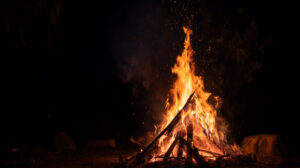Koheles: To Be, or to Appear to Be

A new standard with which to measure our deeds: the standard of eternity
The silo is bursting at its seams. An abundant crop fills his storehouse, and the farmer is beaming with pride and joy.
Yet here and there, the glow of the season is already beginning to fade. The nights are slowly pushing back against the sun’s fierce dominance as the daylight gradually recedes. The heat of the sun is slowly being tempered, and a cool wind is making its presence known in the evening. The lush green of the fields is slowly succumbing to the yellow and brown of the drying stalks and chaff.
Looking at himself in the mirror, the farmer detects the same tinge of creeping decline. Gray streaks his hair, lines crease his skin, and he feels a distinct weariness in his bones.
There seems to be a mean irony to the situation. He has worked so hard to get to this peak, yet once he reaches it, the only way to go is downhill. What’s the point of the climb?
Succos is Chag Ha’asif, the Yom Tov celebrating the peak of achievement. The fields have yielded their bounty, the silos are bursting, and it is the zeman of simchah. Spiritually we reached a peak at Yom Kippur, cleansed of all sin and uplifted spiritually.
But, but…
Where are we headed? A long, dark winter is imminent, so what’s the point of it all?
The answer comes from another farmer who gathered in his crops. His crops were wisdom, and he named his storehouse “Koheles,” a harvest of the fruits of his search. He too began slowly to reflect on the “chaff” — the vanities of life — that covered his fields and were wilting away and disintegrating. It was a moment of great despair. It is disappointing when a person has worked hard and falls short of what he has set out to achieve. A person despairs when he has accomplished everything that he had set out to do and then, at the moment of peak achievement, he perceives the utter pointlessness of those achievements.
Shlomo Hamelech left us a legacy of three works. Shir Hashirim expresses the fire of youth, so eager to accomplish and achieve. The fire of youth gives way to the wisdom and maturity of Mishlei: the understanding of what is good and what is misleading. And at the final stage of life, Shlomo Hamelech wrote Koheles, which on its surface seems just to express gloom (Shir Hashirim Rabbah 1:10). “Everything is emptiness and worthlessness,” goes the refrain, again and again. Is he chas v’shalom repudiating all that he had written before?
To negate this impression, Chazal focused us on the end of Koheles as the central point of the sefer: “For G-d will judge all deeds of man — even those hidden — to determine whether they are good or bad” (Koheles 12:14).
We tend to think of “good” and “bad” as adjectives defining a characteristic of a deed. In a deeper sense they define the essence of our deeds. That which is “tov” has a real existence. Olam Haba is not eternal because its clock has been set to last until eternity. Rather, Olam Haba is the world of “real existence” and, by definition, real existence translates to eternity.
Thus our world of objects and deeds consists of two categories: Those that are real and eternal, and those that are temporal and fleeting. This is the real issue at the fulcrum of Divine judgment. While Divine judgment can be corrective in nature, such as when it reinforces the good that a person does and disciplines him to move away from the bad, the ultimate Divine judgment is existence versus nonexistence.
The Rambam (Teshuvah 8:1) defines Olam Haba as the place where “there is life without death, and good (i.e., pleasantness) without bad (i.e., discomfort).” The primary quality of Olam Haba is “intrinsic existence,” with the pleasantness only being the second characteristic.
Shlomo Hamelech is giving us the benefit of wisdom and experience in order to help us focus our lives. Certainly the blind and undiscriminating fire of youth cannot lead us to the ultimate good. Motivation and fire are the necessary first stage, but are woefully insufficient for the long term. The mature thinking of Mishlei gives us our first insight into how we can distinguish between activities worth pursuing and those that should not be pursued. We do this by viewing life through the lens of “good and bad.”
But as Shlomo Hamelech explored every facet of life and wisdom, a final lens, born of a lifetime of study and toil, takes shape: the lens of existence versus pseudo-existence. Koheles instructs us on how to distinguish things that appear to be good and worthwhile from those that are good and worthwhile to the core.
The Rambam (Peirush Hamishnayos, end of Makkos) states that only deeds that are done lishmah merit Olam Haba. This is not the place to resolve the seeming contradictions in the Rambam and the various Gemaras. Rather, I want to highlight the point that the Rambam is making: In the eternal world, there exists only deeds that are good in their essence — i.e., at the core. A deed that is good in terms of the action itself, but at its core is driven by some temporal motivation such as honor, is a deed whose existence is perforce temporary.
Shlomo Hamelech has shared this with us. Hashem will bring us to final judgment for the good and bad — not only the overt good and bad, but most importantly for the hidden — that which lies at the heart of our deeds. For this is the final determinant as to whether our deeds belong to the “hevel havalim” of our reality, or the eternity of the Divine reality.
Yes, Succos is a point of time that comes every year, when at the very peak of attainment, we begin to feel impending disintegration of those attainments. But that is not entirely correct. The stalk and chaff and masses of ancillary vegetation are shriveling and disintegrating, but the kernel is safely stored, firm and full. It will sustain us, and be sown again to produce another generation, whose seed will be there to produce another generation, and so on, ad infinitum.
Yes, G-d’s judgment is brutally honest, and a lot of what we thought to be worthy and of value is dried and blown away. But there are those few kernels that Divine judgment found to be true to the core, and they became our eternity!
Koheles does not despair of life and achievement. Rather, it bids us to use a new standard with which to measure our deeds: the standard of eternity.
Rav Aaron Lopiansky is the rosh yeshivah of the Yeshiva of Greater Washington, Tiferes Gedaliah, a talmid of Rav Chaim Shmuelevitz, Rav Nachum Partzovitz, and his father-in-law, Rav Beinish Finkel. He also learned under Rav Moshe Shapira. Rav Lopiansky has authored several seforim, including the recently released Orchos Chaim, Ben Torah for Life.
Originally featured in Mishpacha, Issue 781.
Oops! We could not locate your form.













